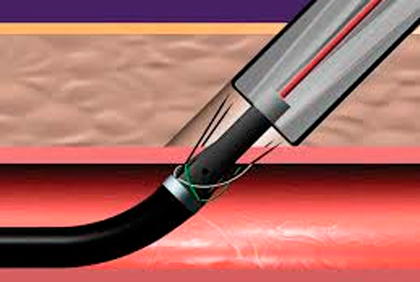In patients who undergo transcatheter aortic valve replacement (TAVR) through transfemoral access, a closure device based on plug technology (MANTA VCD) is associated with a higher chance of access-related complications, but with shorter hemostasis time compared with a device with suture technology such as ProGlide VCD.

Nowadays, most patients undergo TAVR through transfemoral access. Percutaneous closure of the access bears multiple advantages for both patient and operator. However, there are several designs in the market, and it remains unclear which one is the most effective.
CHOICE-CLOSURE was a multicenter study in which patients scheduled for TAVR through femoral access were randomized to a device based on plug technology (Manta) vs. a device based on suture technology (ProGlide).
The protocol did not allow for an extra device when using Manta. In the case of ProGlide, two devices were used (at hours 10 and 14, respectively) and, if necessary, a small plug to help both PloGlide could be used (for example, AngioSeal).
The primary endpoint was major and minor access-related complications during the index hospitalization. The secondary endpoints included access-related bleeding, device failure to achieve hemostasis, and time to hemostasis.
About 516 patients were included and randomized, with a mean STS score of 4.1 ± 2.9% and 7.6% of associated peripheral vascular disease.
Read also: Suture-Based Percutaneous Closure vs. Plug for Large Arteriotomies.
The primary endpoint was reached in 19.4% of the population treated with Manta, and in 12% of those who received ProGlide (p = 0.029). Bleeding rates were better with ProGlide, while device efficacy was similar between both.
In terms of time to hemostasis, Manta was 3x faster (80 vs. 240 sec.; p < 0.001).
Conclusion
In patients who underwent transfemoral TAVR, the Manta device was linked to more vascular complications but reached hemostasis faster than two ProGlide. The time difference in relative terms seems a lot, but in absolute numbers it was barely over two minutes.
CIRCULATIONAHA-121-057856Reference: Mohamed Abdel-Wahab et al. Circulation. 2021 Nov 5. doi: 10.1161/CIRCULATIONAHA.121.057856. Online ahead of print.
Subscribe to our weekly newsletter
Get the latest scientific articles on interventional cardiology





